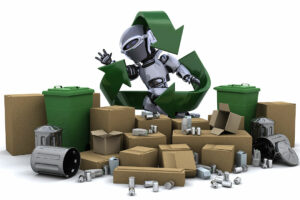Mining our waste

Late last year my wireless printer at home broke down. It needed a new printer head. Other than that, everything else with the printer still worked well. But, given the pandemic, and its impact on global production of electronic parts, it took the service center almost eight months to get the necessary part in. And this was for a repair job — head replacement — that took only a few hours to complete.
I almost gave up on that wireless printer, having bought a cheaper wired replacement months ago as it was needed for work and school. But I felt it would have been a waste to simply throw the thing away. After all, it wasn’t some cheap appliance at the time it was bought. Luckily, I chose to wait it out. Had I chucked that wireless printer, I may not have bothered to look for a recycling place for it. And, it would have simply gone out with the garbage.
I am sure that in the last two years or so, I am not the only consumer that has had to deal with broken electric appliances or electronic devices in need of repair, with replacement parts or components difficult to source. I am also sure that unlike me, a number of these consumers had opted to actually throw away whatever consumer durable that was, and instead bought cheaper replacements. And I mean cheaper as in disposable.
About three weeks ago, it was my washer’s turn to break down. The front-load washer’s door came off after the lock and the hinge broke. To date, there are no parts available for the thing. “Repair” is not exactly an option as the aluminum cast hinge broke into several pieces. All I need is the hinge, as the rest of the door — and the washer — is perfectly fine. Without the door, however, any front-load washer is practically useless.
I had some luck with the printer, although the wait was eight months. Will I have the same luck with the washer? Nobody knows, at this point. The thing is, for want of a single component, an entire appliance can be deemed broken and useless, and may actually end up going out with the garbage. On a daily basis, I can only wonder how many junked electric appliances and electronic devices ended up in dumps. Add to these junked cars, used batteries, and broken wind turbine blades and broken solar panels. Even renewable energy sources produce waste.
In June 2019, Time Magazine published a story titled, “The World Has an E-Waste Problem,” written by Alana Semuels. The story noted that, 1.) less than a quarter of all US electronic waste is recycled, according to a United Nations estimate; and, 2.) the rest is incinerated or ends up in landfills. “That’s bad news, as e-waste can contain harmful materials like mercury and beryllium that pose environmental risks,” Semuels wrote.
She added, “Even when e-waste rules exist, it’s left up to consumers to handle their old devices properly. But recycling them can be a pain… Many consumers, paralyzed by the hassle or put off by the expense, simply throw their devices into the trash or stash them in a drawer, hoping they’ll just disappear.”
In my opinion, it is when people simply throw away these things that e-waste becomes truly problematic. As I noted in a previous column, as battery technology improves, and battery use ramps up as the world turns to electric from fossil fuel, who will handle battery disposal or battery recycling? The shift to electric cars will eventually lead to a crisis in disposal unless we also start working on new systems and technologies for disposal.
Batteries as power sources eventually get spent. Over time, they degrade and require replacement. But, for every replacement, there will be an issue of disposal. I am uncertain if we have enough regulations — or legislation — to manage the disposal of batteries from electric vehicles. Or, for that matter, disposal of solar panels from solar farms and solar homes, and used turbines from wind farms. Over time, all these materials degrade, and are replaced.
The problem is that wind turbine blades from wind energy farms cannot be recycled and are now piling up in landfills. As for solar, the International Renewable Energy Agency estimates that by 2050, up to 78 million metric tons of solar panels will have reached the end of their life, and this will result in about six million metric tons of new solar e-waste annually. And with solar panels, when they break down, toxic waste does go into the soil.
As we require industries and businesses to clean their air emissions and their water discharge or general effluents, then we should also require electric car makers to recycle their own batteries; wind farms to recycle their own turbines; solar farms to recycle their own panels; and, computer makers and mobile phone makers to recycle their own e-waste. Their waste shouldn’t end up in landfills.
There is a call to actually start mining our e-waste. There is money in garbage. Landfills still attract scavengers, looking for items that can still be reused and sold for some profit. Surplus, as we used to refer to second-hand but reusable car and engine parts sold. The same goes for many other consumer durables. My old printer, for instance, could have yielded plenty of usable parts and components. The same goes for my old washer. That is, had I opted to throw them out.
“The proliferation of digital devices has already become a big problem for the planet, but it’s still not receiving the attention it should. Once they come to the end of their useful lives, electronics just get discarded. The recycling rate is still poor, despite the fact they contain valuable minerals that could be used once more and have economic value. Now, scientists are calling to ramp up the recycling of e-waste, describing the expansion of mining as unsustainable,” noted the recent article by Fermin Koop in ZME Science, an online science news site.
Koop cited a UN report that noted, “A record 53.6 million metric tons of electronic waste were generated worldwide in 2019, up 21% in just five years… E-waste is also predicted to reach 74 million metric tons by 2030, almost doubling its actual figures in 15 years. This makes e-waste the fastest-growing domestic waste stream on a global scale.”
He added, “The growing figures are triggered by the high consumption of electronic equipment, short life cycles, and limited options for repair. Only 17% of 2019’s e-waste was collected and recycled, the UN found. This means that high-value materials valued at $57 billion were mostly dumped or burned rather than collected for treatment and reuse. So, recycling electronics is not only an environmental choice but one that could yield economic benefits.”
Koop also wrote that “electronics contain dozens of different elements, many of which are technically recoverable, though there are economic limits set by the market. E-waste has precious metals including gold, silver, copper, platinum, and palladium. It also has valuable bulky materials such as iron and aluminum, along with plastics that can be recycled.”
It is in this line that I encourage the incoming Congress to look into the possibility of legislating stronger and more practical policies and regulations on e-waste disposal and recycling. It should also consider the disposal of waste from renewable energy sources like solar panels and wind turbines and batteries.
Indeed, our greater reliance on electronics and computers, as well as the shift to renewable energy and other non-fossil fuel sources to save the environment, are the very things that will become the source of our environmental challenges in the future. We should start planning things better and looking into viable and more sustainable “clean up” options.
Marvin Tort is a former managing editor of BusinessWorld, and a former chairman of the Philippine Press Council




